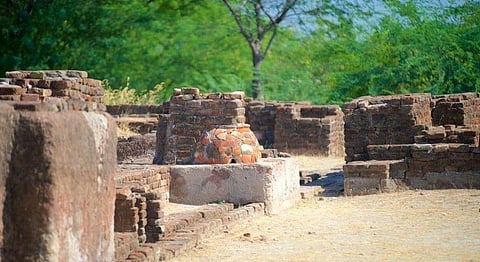
- HOMEGROWN WORLD
- #HGCREATORS
- #HGEXPLORE
- #HGVOICES
- #HGSHOP
- CAREERS
- ABOUT US
- CONTACT US

I imagined the past again. Or rather, tried to, in the City of the Dead. It was my second day in Gujarat and I was taking a trip back in time. Or atleast that is what it felt like as I stood amidst the the 5th largest Harappan Excavation site, in a village called Lothal, about 75 km away from Ahmedabad.
Dipped in hues of brown and red, I only saw blocks and pavilions from a distance in Lothal, that translates to the mound of the dead. An information board nearby told me that the site was discovered in 1954 and excavations began in February 1955. With hardly anyone around, our guide, Mr Heerabhai led us the through ruins of this ancient civilization. I tried to picture the bustling life, the guide spoke about while taking us on a tour.
Boats arriving from Mohenjo-Daro and Western Asia through the River Bhogava and River Sabarmati (both, which have now receded) on the either side of the village and stopping at the huge dockyard for trading purposes, the labour working in bead factories, the chaotic hustle in the market, folks making their way in and out of the community kitchens and bathrooms, stopping by to pay respect to the ruler in the acropolis; life seemed idyllic. But looking at what was left of it today; bricks and ruins baking under the scorching sun, it is fascinating to even think of the presence of a civilization here.
Looking at it now, the presence of water in an arid land like this seems like a mirage but the 14 m long and 35 m wide dockyard here, supposedly the world’s earliest known, denotes otherwise. Here boats could sail to the village as recently as 1850. It is perhaps the most astounding example of Harappan architecture. Today it is arid and cracked.
Lothal was a thriving centre for the Indus Valley civilisation that survived for years withstanding floods and harsh weather conditions. However the village existed before the arrival of Harappans as well, which happened in 3000 BCE. Earlier, it was a small riverside village that provided access to the mainland of Gulf of Khambat. The people here were supposedly affluent as indicated by he discovery of copper objects, beads and semi-precious stones . However after a ravaging flood destroyed the village, the Harappans nearby Sindh took advantage of the site and built the city from scratch.
The fact that the town was well planned is evident from the visible traces of proper drainage systems, community kitchens, bathrooms, factories and a citadel. There was a designated space for the ruler in the market area which is the citadel while the labour class was supposed to live in the lower town, further away. A huge block is what was earlier the bead factory. Infact, Harappan’s approach to bead making and metallurgy was pioneering and it withstood the test of time. “Harappans were very advanced and disciplined people”, Heerabhai tells us. “But a few sites in Lothal like the labour town and the cemetery have still not been excavated due to lack of funds and grants”, he said pointing grimly to a plain muddy ground. The last survey was done back in 2005.
A museum here, houses artifacts which were excavated from the site. Beads, shells, wooden toys, animal figurines, ceramic ware, copper utensils, skeletons from joint burials, and even paintings of what this Indus Valley Civilization would have been like in 3700 BC, making the past a little more believable.
The city may be lost and dead, but when you gaze at the sprawling excavation site, you imagine life.
Visiting excavation sites may be fascinating, but it should done with utmost responsibility. Kindly do not trod, litter or manipulate the site.
Lothal is about 80 kms from Ahmedabad, and the frequency of buses is low. Renting a cab is advisable. There are no places of accommodation in the village.
If you enjoyed reading this article, we suggest you read:
